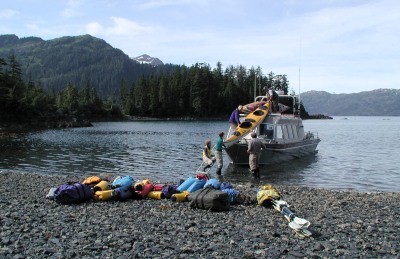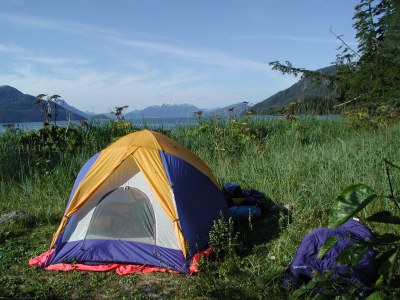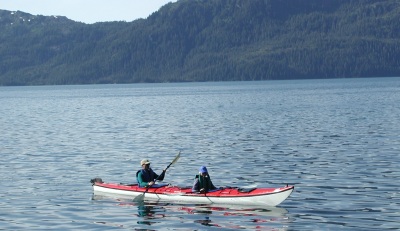Glacial Thunder: Sea Kayaking
in Prince William Sound 2001
Drop-off in PWS
Saturday, August 11 Prepared for more traffic jams on the Seward Highway, and knowing that we had to deal with the rental car mess at the Airport, we had arranged for our B&B hostess to have another magnificent breakfast ready for us early ( I believe it was pancakes, maple syrup, and some yogurt with fresh berries from her garden), and we were outta there by 7:20 am. (Since it was light at 4:30 am or so, a 7:20 departure seemed positively decadent.) We went through a complex car exchange (too complex for this tale), ending up with our original five passenger car and a short wheelbase mini-van. The minivan was packed to the proverbial gills with gear, and the car was packed with people, and a trunk-full of non-gear. We headed off down the Seward Highway, stopping briefly (once through the only-half-hour traffic delay) at Girdwood for coffee and bathrooms. OK, I confess, I had gotten a bit desperate for a Diet Mountain Dew, and knew this was my last chance for over a week to feed my dependence. With potential delays looming at the new Whittier Tunnel, we had collectively decided to forego any pretext of sightseeing and get into Whittier as soon as possible. The day looked pretty promising, with about 60% clouds and the remainder as blue sky. Things could be a lot worse, for sure. Catching the 10:30 am pulse through the tunnel (vehicles can only go one direction in the one lane tunnel, which seems like some classic rocky-sided hole out of a World War II movie), we pulled into the surreal world of Whittier, Alaska before 11 am. To be sure, Whittier is a strange place: Built originally by the military as a fuel supply depot at an ice-free port during World War II, the only residential facility is one 13-story high rise apartment building, reminiscent of what the Chinese would throw up. (The old abandoned high rise, with its windows all gone, added a nice third world touch.) There are a few out-buildings, acres of gravel parking, and a couple of tourist shops, probably the crudest public bathrooms I have ever seen in this country, and most importantly, the harbor and its fleet of boats. It is not clear to me why tourists without a water destination bother to pay the $15 - $40 tunnel toll to visit Whittier, but then, I don't understand Six Flags either.
Diane was the planner of this trip.  She had contacted the leader of the Sierra Club trip they had taken a few years ago, carefully mapped the campsites which the latter recommended (and in hindsight, for a non-map type person, Diane did a magnificent job of getting the locations correct), arranged to rent the small fleet of kayaks (three doubles and one single) from Alaska Sea Kayakers and the water taxi service (think waterborne bush pilot), Honey Charters required to take us to where we wanted to sea kayak at what turned out to be a very reasonable fare. In a way, scheduling a water taxi run and drop off this far out takes some planning. Tide, of course is the critical factor. In Alaska, the tides can be substantial, running up to 25 - 35 feet. In the area in which we were kayaking, our biggest tide came near the end of the week, about 4 meters, or maybe a little over 13 feet. In the best of all possible worlds, you do not want to attempt a landing in a boat where the "beach" is shallow and the tide going out. That is a recipe for spending the night with your boat captain. We had arranged to be dropped off at a spot near the mouth of Whale Bay, about a 60 mile run out of Whittier. The folks from Alaska Sea Kayakers seemed please to see us a bit earlier than expected (we had originally scheduled a 1 pm show up time and 2 pm departure). To their credit, they took a lot of time going over some safety issues with regard to the icebergs we would encounter, and how to pack our kayaks. By the time those of us who needed rental boots had picked them out, they had our kayaks down to a spot where we could practice packing them. One guy took an immense amount of time with us, giving us pointers on how to squeeze even more air out of our dry bags, and to pack them perpendicularly to the long axis of the kayak in some of the holds. Susie and I, as the rest of the couples, were in a Seda Tango. As one review I read of the boat claimed: it is a racehorse at mule prices. It is designed for both racing and expedition kayaking, having a large center bulkheaded hatch, ideal for heavy stuff like food bags, boxes of wine, or cases of beer. Despite its 21 foot length, it weighs less than a hundred pounds, although I have to admit that we found it much easier to move these kayaks over the slippery rocks on shore with four people on an empty boat, and 6 people on a full boat.
She had contacted the leader of the Sierra Club trip they had taken a few years ago, carefully mapped the campsites which the latter recommended (and in hindsight, for a non-map type person, Diane did a magnificent job of getting the locations correct), arranged to rent the small fleet of kayaks (three doubles and one single) from Alaska Sea Kayakers and the water taxi service (think waterborne bush pilot), Honey Charters required to take us to where we wanted to sea kayak at what turned out to be a very reasonable fare. In a way, scheduling a water taxi run and drop off this far out takes some planning. Tide, of course is the critical factor. In Alaska, the tides can be substantial, running up to 25 - 35 feet. In the area in which we were kayaking, our biggest tide came near the end of the week, about 4 meters, or maybe a little over 13 feet. In the best of all possible worlds, you do not want to attempt a landing in a boat where the "beach" is shallow and the tide going out. That is a recipe for spending the night with your boat captain. We had arranged to be dropped off at a spot near the mouth of Whale Bay, about a 60 mile run out of Whittier. The folks from Alaska Sea Kayakers seemed please to see us a bit earlier than expected (we had originally scheduled a 1 pm show up time and 2 pm departure). To their credit, they took a lot of time going over some safety issues with regard to the icebergs we would encounter, and how to pack our kayaks. By the time those of us who needed rental boots had picked them out, they had our kayaks down to a spot where we could practice packing them. One guy took an immense amount of time with us, giving us pointers on how to squeeze even more air out of our dry bags, and to pack them perpendicularly to the long axis of the kayak in some of the holds. Susie and I, as the rest of the couples, were in a Seda Tango. As one review I read of the boat claimed: it is a racehorse at mule prices. It is designed for both racing and expedition kayaking, having a large center bulkheaded hatch, ideal for heavy stuff like food bags, boxes of wine, or cases of beer. Despite its 21 foot length, it weighs less than a hundred pounds, although I have to admit that we found it much easier to move these kayaks over the slippery rocks on shore with four people on an empty boat, and 6 people on a full boat.
There ended up being very little time for a leisurely lunch, and milling about and "enjoying the sights" of Whittier. About noon, we could see a Honey Charters boat pulling into the harbor, getting ready to drop off a load of people and gear. It was clear that we would be next, and in a minute or two, there seemed to be a cadre of helpers swarming all over the kayaks and gear piles, like ants at a picnic. In a matter of minutes, we were loaded and ready to go. I was thankful for the hearty breakfast that we had enjoyed, because lunch would be a granola bar on the boat. As soon as we were out of the harbor traffic, our captain pushed the twin motors up to something like 5000 rpm, and we were veritably skimming over the water at a glorious 30 knots. I chatted with Pete Heddell, as he explained how he had retired from the Alaska State Police, and started a water taxi service in the summer of 1988. Recalling the Exxon Valdez disaster of 1989, I asked him how he had fared, given that he was trying to set up a primarily recreationally-oriented business at a time when recreational use of Prince William Sound was plummeting. He explained that he had spent so much time shuttling clean up crews out into the sound that he did not have to worry about sea kayakers, and in that one summer, he had essentially paid for the boat in which we were now riding. This was clearly a man who knew how to turn lemons into lemonade.
 After going out the long Whittier Channel, we turned south, and Pete announced that because it was such a pretty day, he would take us down through Culross Passage. This route provided a very intimate introduction to the beauty of this area, as the passage goes past tiny bays, seemingly only a hundred yards wide in spots, and was my favorite part of the 2+ hour boat ride. As we went past Chenega Island, we could spot some whale spouts in the distance. Pete slowed the boat once we were near the spouts, but to no avail. The whales where not in the mood for putting on a show. The water was like a mill pond as we swung around the south side of Verdant Island, and headed for our landing spot on the east side of Whale Bay, in a tiny cove just east of the head marked Vega.
After going out the long Whittier Channel, we turned south, and Pete announced that because it was such a pretty day, he would take us down through Culross Passage. This route provided a very intimate introduction to the beauty of this area, as the passage goes past tiny bays, seemingly only a hundred yards wide in spots, and was my favorite part of the 2+ hour boat ride. As we went past Chenega Island, we could spot some whale spouts in the distance. Pete slowed the boat once we were near the spouts, but to no avail. The whales where not in the mood for putting on a show. The water was like a mill pond as we swung around the south side of Verdant Island, and headed for our landing spot on the east side of Whale Bay, in a tiny cove just east of the head marked Vega.
The hour was early, the weather good, and the air warm. How could you beat it? Well, you could eradicate about 10 quadrillion bugs from this area of Prince William Sound. It was not long after we had hauled our kayaks to a safe distance above the high tide mark, and got our gear bags moved to some good tent sites, that our winged friends joined us for a party. I think Susie had her bug net on in a matter of seconds. The rest of the folks decided to take the kayaks out for a spin, ostensibly to get the "feel" of the boats. I would claim it was to get away from the bugs. Susie and I felt like we would get plenty of "feel" tomorrow on our 9 mile + day trip, and elected to sit down by the water and catch a few bug-reducing breezes. Interestingly, I felt less isolated than I did on our Chitistone Canyon trip in Wrangell St. Elias, even though the trip into this point was much longer (2 hrs vs 30 minutes). I think the fact that there was water, and therefore likely to be boats around, made it seem less remote. However, if one had any thought, just because we were still attached to the mainland, of walking back to civilization, a quick look at the map would show that we were totally isolated by the huge Sargent Ice Field on this part of the Kenai Penninsula. To cross glaciers so huge and fractured would be tantamount to tying a couple of concrete blocks around your feet and jumping overboard in the middle of the Bay. Either approach would have the same result.
 Our friends reported seeing a bear around the cove to the north, which encouraged us all to locate some sort of tree on which to hang our food bags, once dinner was eaten. My gut feel was that there was nothing around here that would stop a Smokies bear, but then, hopefully, these bruins were more interested in the current salmon run than in freeze dried food packaged in plastic, stored in plastic bags, which were in turn stored in nylon stuff sacks, which were stored in the coated nylon dry bags. Hell, I was more interested in the salmon. We all encouraged Tim to put his fishing license to good use once T&D beached their kayak, but tonight, it seemed we were destined to eat the stuff the bears would ignore. For Susie and I, it was Cajun Beans and Rice with dried ham, washed down with surprisingly good (based on the rot-gut swill comment of Susie's the night before) "Mountain Burgundy." We had managed to squeeze in, albeit with some mighty twisting, a 5-liter box, which might last the two of us the entire week if the weather was not too bad. Only time would tell. We tried to stay in the region of highest breeze, to keep our winged friends at bay. Everyone but Tim and Diane seemed to have bug nets with them. Tonight, the nets seemed good to have, but not critical. I actually got by with a cap and wetted bandana for most of the evening. It had been a nice day, and the weather did not look like it would deteriorate all the way to rain anytime soon. I was amazed: on our last trip to Alaska, it had rained on us parts of 14 of 17 days. This time, we had gone 72 hours with nary a drop. How long could it hold?
Our friends reported seeing a bear around the cove to the north, which encouraged us all to locate some sort of tree on which to hang our food bags, once dinner was eaten. My gut feel was that there was nothing around here that would stop a Smokies bear, but then, hopefully, these bruins were more interested in the current salmon run than in freeze dried food packaged in plastic, stored in plastic bags, which were in turn stored in nylon stuff sacks, which were stored in the coated nylon dry bags. Hell, I was more interested in the salmon. We all encouraged Tim to put his fishing license to good use once T&D beached their kayak, but tonight, it seemed we were destined to eat the stuff the bears would ignore. For Susie and I, it was Cajun Beans and Rice with dried ham, washed down with surprisingly good (based on the rot-gut swill comment of Susie's the night before) "Mountain Burgundy." We had managed to squeeze in, albeit with some mighty twisting, a 5-liter box, which might last the two of us the entire week if the weather was not too bad. Only time would tell. We tried to stay in the region of highest breeze, to keep our winged friends at bay. Everyone but Tim and Diane seemed to have bug nets with them. Tonight, the nets seemed good to have, but not critical. I actually got by with a cap and wetted bandana for most of the evening. It had been a nice day, and the weather did not look like it would deteriorate all the way to rain anytime soon. I was amazed: on our last trip to Alaska, it had rained on us parts of 14 of 17 days. This time, we had gone 72 hours with nary a drop. How long could it hold?
© Roger A. Jenkins & Suzanne A. McDonald, 2001
